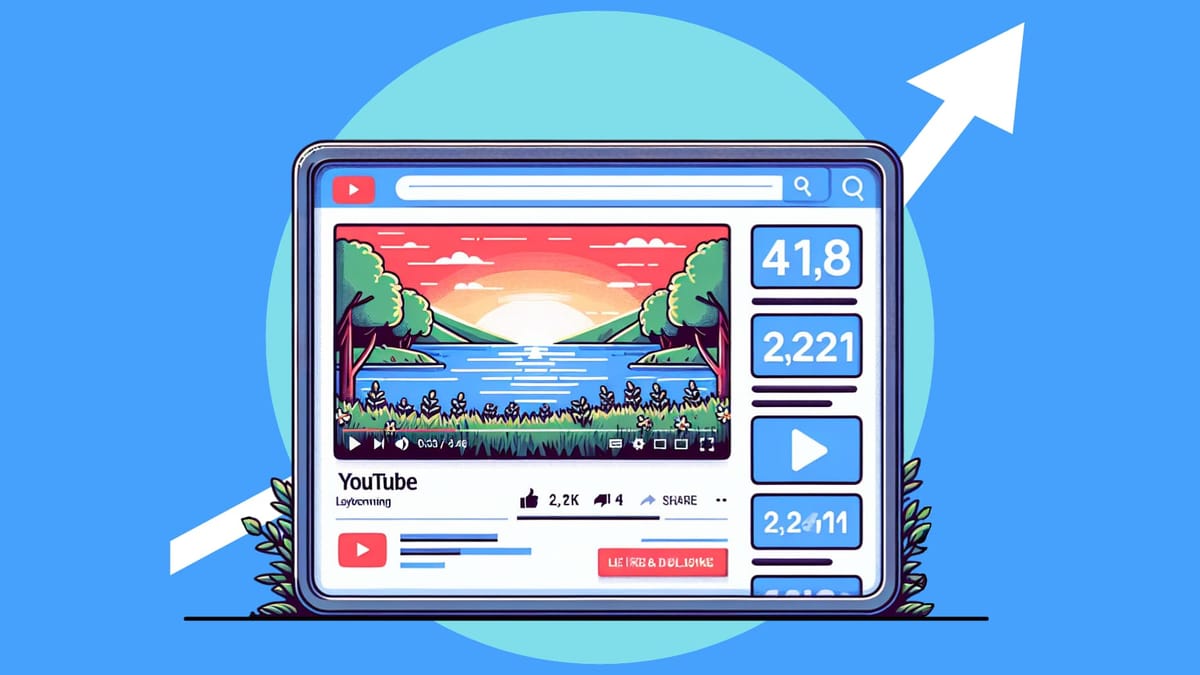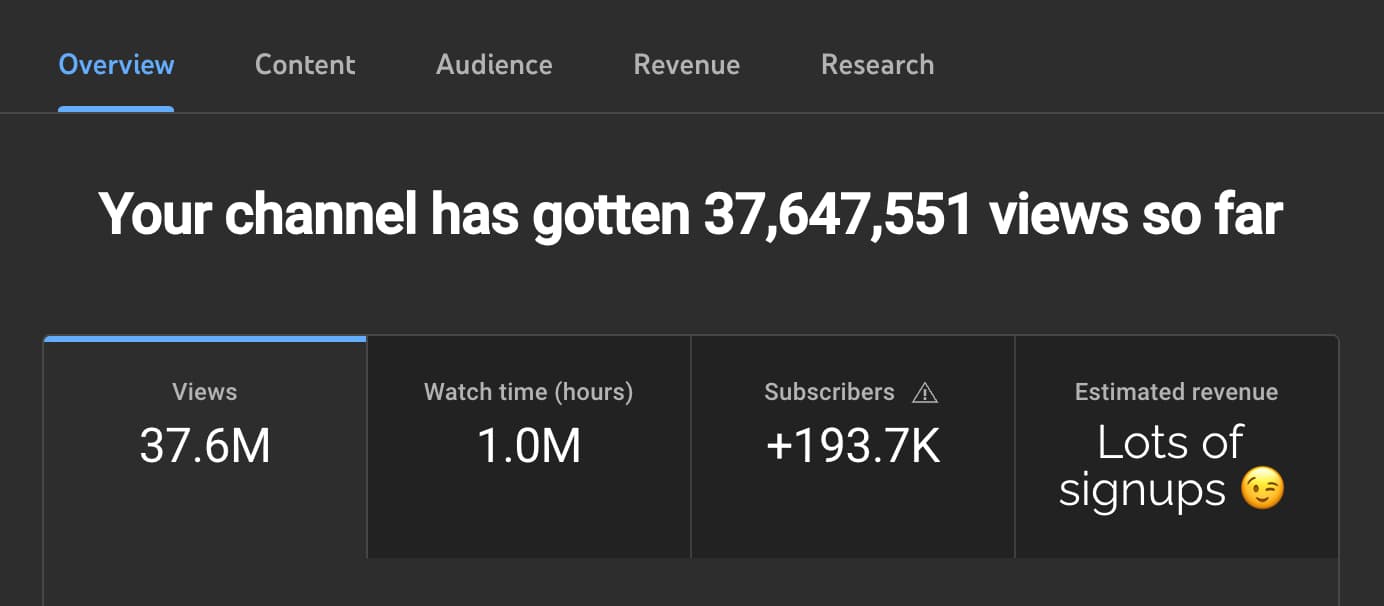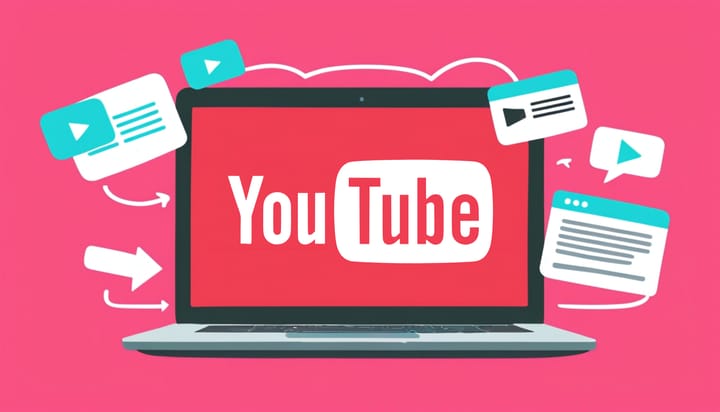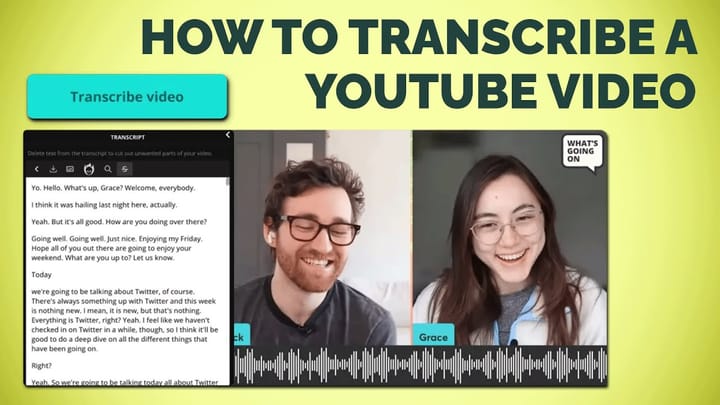How to Go Viral on YouTube: Lessons from 37.6 Million Views
We're sharing our hard-earned insights about how to go viral on YouTube as a brand account, with examples from our own channel.

There’s a lot of advice out there about how to go viral on YouTube. Some of it’s even good advice. But it's mostly tailored to individual creators—there’s not much advice about what makes a good viral video for brand accounts.
Today, we’re looking at Kapwing's brand account on YouTube to share our insights into what makes good viral content. We’ll share lessons learned from going viral* on YouTube ourselves and examples of some of our best (and worst) performing videos.
*We’re using “viral” in a brand context here. As you'll see, it’s all relative.
7 tips for making a viral YouTube video (from our experience)

Lesson #1: Create the first, best video on a rising topic
One way to get traffic to your YouTube videos is by moving quickly on topics with growth potential.
That’s not the same as trend hopping, or jumping on a trending topic just to get the temporary boost in views. Trend hopping can work but you run the risk of building an archive of videos that only see “spiky” performance with no ability to grow views over time.
Worse yet, your audience may be as fleeting as the trend.
When you chase trends too often, do you really have an audience or do you just have views?
The better approach is to be the best video on a topic and be the first to do the topic justice. You don’t have to be the first video ever on the topic, as that’s unrealistic. But you should aim to be the first video to truly give people what they want. As a corollary, if you can't find a satisfying video on a topic during your own search, that's a great sign to make the video yourself.
Some of our most popular videos still accrue views to this day because they cover evergreen topics, but they only earned their initial traction by being early to market before there were hundreds of other great videos on the same topic.
Some things to look for when evaluating a video topic for growth potential:
- Does a good, in-depth, up-to-date video about this topic already exist? A quick search on YouTube should answer this question for you.
- Is this topic relevant to your channel goals? Not every video on your channel has to be about your product (in fact, they really shouldn’t all just be product ads and demos). But, the topic should be of interest to your target audience. Industry news, educational content, and related tech reviews are examples of topics that could be worth pursuing.
- Does this have the potential to get big? This question is more of a gut check. Have you seen people talking about this elsewhere online? Has it come up in Slack channels you’re in or on your LinkedIn feed? These are all signs of "pent-up demand," i.e., people really struggling with this challenge and desperately want a solution.
Lesson #2: Target YouTube search to go "slow viral"
Tutorial content performs well for us in terms of views, but it’s often a slow build rather than a rapid takeoff. The videos continue to acquire views over time because they get enough early traction to rank in YouTube search. We target search terms related to the video and the long-term payoff from this approach is significant.
Of course, having a video blow up overnight would be great, but it’s hard to go viral from YouTube’s “Recommended” tab alone and far less consistent. Focusing only on quick wins carries more risk with (arguably) less total upside.
Instead, we recommend search-focused topics. This is the best approach for brands to take and can lead to going “slow viral”—building views over time that contribute to your overall channel growth, instead of just one video’s success.
Trying to go slow viral on search is usually a numbers and consistency game where you pick out all the most useful topics your potential customers might search for on YouTube and try to meet them during their search. Much how you would do with traditional SEO when trying to catch people during their Google searches.
Another way “Views from YouTube search” is similar to traditional Google search: they compound over time. If you’ve done your keyword research correctly, your search-focused videos will grow passively. And when you have many dozens of videos earning views over long periods, that's how you can grow your reach, subscribers, and view totals without landing on a viral video each month.
Lesson #3: Don't stop experimenting with formats and topics
Looking at which videos and approaches worked best for our YouTube channel (examples below), things may seem obvious in retrospect. But we had to draw these conclusions through hard-won experience and lots of experiments.
If you’re not frequently experimenting with video formats and topics, it’s extremely hard—even for experienced content creators—to predict what's definitely going to go viral on YouTube. You may have a hunch, but running many experiments gives you the data to back up your instincts.
Even experienced content creators find it (almost) impossible to predict what's going to go viral. You have to experiment.
And doing the experimenting yourself is pretty key. What works on YouTube varies widely from channel to channel and industry to industry, so what rocketed someone else to success might result in only flops for you. You need to be able to draw conclusions from your own experience and data.
Frankly, some commonly-heard advice on going viral didn't work for us, while ideas people rarely talk about performed extremely well. Experimenting with different video ideas, thumbnails, titles, hooks, and formatting were the only way to learn what truly worked.
Try our AI YouTube Shorts Generator to automatically get multiple YouTube Shorts with different topics to experiment what works best for your channel.
Lesson #4: Thumbnails and titles matter, but must match the video
Our tutorial videos do incredibly well with simple thumbnails that help reinforce what we're helping someone solve. No shocked face (😱) needed to drive clicks; in fact, this probably would hurt performance.
Thumbnails with over-the-top visuals or faces wouldn't match a typical viewer's experience when discovering a tutorial video. They’re running a search with a problem already in mind and are looking for answers, not sensationalism and clickbait.
More straightforward titles also seem to help with discoverability in YouTube search. You should strike a balance between being clear and being interesting, rather than just going for intrigue. Titles like that are better suited to videos that most earn views from Recommended.
That said, for videos where we didn't target a deliberate keyword, it was clear looking back that many of our flops lacked the intrigue needed to earn a click when a viewer wasn't actively searching for something. These types of videos will likely be shown to viewers with similar interests (thanks, algorithm 🙏), but you don't know the viewer's state of mind, so creating a really strong sense of curiosity—“I must know what's in this video”—is the only way to earn their attention.
Lesson #5: Obsess over your click-through rate
It’s easy to get caught up in looking at watch time and viewer retention when measuring a video’s success on YouTube. And while these are undeniably important metrics, it's interesting to note some of our flops have higher view durations than our most popular videos.
So, what's another leading indicator of success, then? Look at your click-through rate.
The most common area where popular videos over-performed was CTR. Our less popular videos have CTRs around 1-2%, whereas our hits are between 10-20%.
CTR is undeniably affected by a video's overall popularity—highly-viewed videos are recommended more often—but your video's ability to earn the click wherever it's seen is a strong indicator that it will continue on its growth trajectory. At least, so long as the topic stays relevant.
Lesson #6: Master the art of repeated hooks
Regardless of video type, we've learned you have less time than you think to keep someone engaged. The first 5-10 seconds are critical and their sole purpose is to keep someone watching for the next minute. The data doesn't lie: You really don't have much time to earn a viewer's attention.
That said, just because you’ve got a killer intro doesn’t mean your work is done. You need to re-earn people’s attention throughout the video if it’s longer than just a few minutes. Some of our flops highlight what happens when you don’t do this—people drop off before the content gets to some of its best moments.
"Repeat hooks" are little moments in the middle of your video where you incentivize viewers to stick around. It can be as simple as mentioning or previewing something you'll reveal later in the video, just so the viewer knows it's coming and anticipates it.
Some examples of repeat hooks to add to your videos:
- The “But first…” Verbally hint at something you’ll reveal later in the video, “but first” you have to explain, show, or share something else.
- The open loop. Ask a question that you promise to answer later in the video.
- The teaser. Show a quick preview of something that you’ll reveal in more detail later in the video. For example, if you’re filming a tutorial, this could be a shot of the final product.
- The reminder. Remind viewers of the value they’ll get out of your video by sticking around and watching the whole thing.
Lesson #7: Remember "viral" is relative
We’ve been throwing the word viral around a lot, but it’s important to remember that “viral” is relative. Something that’s viral to a brand account like ours would hardly scratch the surface of the word for a big creator with over 5M subscribers.
Virality is also dependent on the kind of video you're making, too. Videos that are deeply connected to your product don't need to go mega-viral to have a significant impact on your business. In fact, the closer a video is to your product the less "viral" it needs to go in order to create impact—at least, usually.
The closer a video is to your product, the less "viral" it needs to go.
We've had Kapwing tutorials that earned fewer than 100k views create more measurable business impact than other videos with five times the views. It's all relative.
So don't set virality as a universal goal. Pair the content of the video to the goal of the video and use a metric that makes the most sense to track performance. When some version of "reach" truly is your goal, virality and views are perfectly fine measures.
Viral YouTube examples: Wins and sins from our channel
We learned these lessons through trial and error, so we feel it’s only fair to share some of what that process looked like. Now, we’ll share both our viral hits as well as our total flops, complete with a breakdown of some of our YouTube stats.
Let’s use the "Wins" and "Sins" format to reflect on what went well and where we swung and missed.
Win #1: How to Make and Sell an NFT (Crypto Art Tutorial)
This video about how to make and sell an NFT key did a lot toward putting our YouTube channel on the map. We were one of the first channels to cover how to create an NFT, which helped us capture that early traffic on a topic that a lot of people were hyper interested in.
What went well:
- This video alone has contributed to over 1/4 of our total subscriber count.
- The high view count and higher view duration helped drive traffic to our other videos, tipping off YouTube’s algorithm to recommend our content, at least initially.
What could be better:
- The topic isn’t really in line with what our product is used for, which means this video isn’t a great fit for attracting users who are most likely to try Kapwing.
- Given that lack of fit, these viewers largely became inactive and don’t continue to contribute to average views gained on new videos. It was a nice kickstart, but the long-term value of this video is lessened for this reason.
YouTube analytics at a glance:
- Nearly 4.4M views since publication
- 4:00 average view duration
- 38% average percentage viewed
- 11% CTR
Win #2: How to Make Any Video Sound Your Alarm or Ringtone
This is more of an example of a video of ours that went “slow viral” and has continued to perform well over time. 63% of the traffic comes from YouTube search, which tends to be the case for most of our top performing videos. Search-focused topics perform better and have more sticking power on our channel.
What went well:
- Our highest viewed video on our channel that continues to earn views for us. If you look at the above graph compared to the NFT video, you’ll see the growth in views hasn't stalled at all.
- The topic is also somewhat more of a product fit—people use Kapwing's Video Converter to transform video and audio files into many different formats.
- Not only does this video have one of the highest click-through rates on our channel, we can trace back a lot of new accounts to this video.
What could be better:
- While this video earned a lot of new signups, it didn’t necessarily net us as many best-fit users because it targets a general audience, rather than marketing and video creation professionals, who are looking to solve business-oriented problems.
YouTube analytics at a glance:
- Over 5.4M views since publication
- 1:31 average view duration
- 28% average percentage viewed
- 19% CTR
Win #3: Kapwing Tutorial: How to Use the Kapwing Video Editor in 2024
This is another slow-growing video but one that can be traced back to a meaningful number of signups for our product. A full product tutorial like this is probably something worth doing every year to capture demand from new users and make sure the information circulating about your product is up to date.
What went well:
- This video isn’t quite “viral” in the traditional sense, but it’s a really successful example of a full product tutorial that is helpful for users.
- There’s an obvious product fit here—it’s a complete tutorial about our flagship video editor and key features.
- About 25% of the views to this tutorial come from external sources because we’ve embedded this video across our website and blog, where it would be most useful to visitors.
What could be better:
- This is a pretty high-effort project; the video is about 20 minutes long and covers a wide breadth of the tools in our product.
- Because we’ve already published Kapwing tutorials, we are competing against our own content with topics like this. You (still) can’t update videos on YouTube, so we felt pretty strongly about publishing the new video anyway, since our product has improved so much.
YouTube analytics at a glance:
- 71K views since publication
- 2:36 average view
- 12% average percentage viewed
- 9% CTR
Win #4: How to Resize Videos for YouTube Shorts
Simple editing tasks can be useful when new platforms or techniques arise.
What went well:
- We jumped on this topic early, publishing this video shortly after YouTube Shorts were first introduced. That netted us an early bump in traffic and still results in consistent traffic now.
- This topic sits neatly at the intersection of relevant to our product, timely, and evergreen.
- The thumbnail and title are both simple, straightforward, and well-suited to a search-focused topic (over 70% of the traffic to this video comes from YouTube search).
What could be better:
- The traffic to this video leveling off a bit. Resizing videos for Shorts was a more novel topic back then, and nowadays video creators have access to tools like Repurpose Studio and others and have built a standard workflow for doing this task, so a tutorial might not be needed as much.
YouTube analytics at a glance:
- 548k views since publication
- 1:21 average view
- 25% average percentage viewed
- 12% CTR
Win #5: How to Use Text to Speech on TikTok
Another platform-specific tutorial. We’ve had a lot of success with these topics, especially when we move on them early. This video also serves as an example of why you can't always wait for topics to display high or consistent search volumes—we picked up on this topic as it started becoming more popular on TikTok itself, before keyword tools began to notice.
What went well:
- Even though this topic isn’t a 1:1 product fit, there is still a fit. We give an alternative to TikTok text-to-speech by using Kapwing.
- This video delivers what the viewer is searching for and also presents a related use case that they might not have even known they wanted.
What could be better:
- Similar to the YouTube Shorts tutorial, the growth on this video tapered off pretty naturally. The TikTok text-to-speech UI has changed a lot in the last few years and this video is no longer the most up-to-date resource.
YouTube analytics at a glance:
- 1.5M views since publication
- 1:19 average view
- 39% average percentage viewed
- 18% CTR
Now for some videos that didn’t get such a hot reception.
Sin #1: Here’s How to Make Your Vlogs Actually Good
This video was an attempt at a different style, more of an opinion piece than a tutorial. It was a fun video to film and we’re proud of the final product, but the search fit just wasn’t there.
What went well:
- Experimenting with form and content is always a good idea, and this was definitely an experiment! We enjoyed filming it and feel that the quality is high—insightful content with lots of visually interesting B-roll from around New York.
- The video itself is easy to follow. It has a structured agenda, which is helpful when the title doesn’t spell out for you what to expect (e.g., “5 Tips for Better Vlogging”).
What could be better:
- We didn’t do enough keyword research around the topic to nail down how people were searching for this subject on YouTube.
- The thumbnail and title are both pretty vague. We chose “How to Make Your Vlogs Actually Good” as the title because it’s a little cheeky and sometimes that can get clicks, but something more straightforward and search-friendly like “5 Essential Tips for Vlogging” would likely have worked better.
- The topic itself might be too broad. Instead of including tips about gear, story arc, and filming all in one video, this might have made a good series, going into depth on each topic and really nailing the search terms for each.
YouTube analytics at a glance:
- 1k views since publication
- 1:47 average view duration
- 27% average percentage viewed
- 1.1% CTR
Sin #2: How Few Views Do You Need to be a Full-Time YouTuber
This video tackled a topic we felt was relevant to our viewers and features an interview with a subject matter expert, but it didn’t get much traction.
What went well:
- The interview with our guest, Creator Wizard, was interesting and broached a topic we felt was undercovered and relevant to creators.
- Average view duration for this video is pretty good for our channel.
- The engagement with this video was decent, which means the topic and the content resonated, but there just wasn’t enough reach.
What could be better:
- We lost a lot of viewers due to a slow intro. Instead of spending so long on “What is a living wage” and doing calculations, it would have been better to jump right into the interview with Creator Wizard.
- There wasn’t enough search volume or initial traction to push this video into the Recommended section, and without a strong keyword to surface in search results, there wasn’t really anything to drive people to the video.
YouTube analytics at a glance:
- 1k views since publication
- 3:30 average view duration
- 35% average percentage viewed
- 1.2% CTR
Sin #3: What a Creator with 15 Million Followers Can Teach You About Social Media Success ft. Cowbelly
This is another creator interview with more of a case study format that saw slightly better results but still didn’t reach the audience we were hoping for.
What went well:
- The interview itself is great and packed with lots of insightful info about Cowbelly’s online community and business model.
What could be better:
- This is another example of a video that didn’t attract search traffic but also didn’t perform well enough to get recommended. Notice a trend?
- The title is probably too long and doesn’t target any one specific search term.
- We were hoping for crossover traffic from Cowbelly’s audience or name recognition in search to help with click-through, but even though he’s got 15M followers, he’s not really a household name so this bet didn’t pay off.
YouTube analytics at a glance:
- 3k views since publication
- 1:43 average view duration
- 21% average percentage viewed
- CTR 1.5%
Experiment to find your own best viral tactics
These lessons and examples are meant to give you a jumping off point to support your own YouTube growth journey. But this isn’t an exact roadmap because what worked for us may not work for your channel.
In fact, through our own efforts, we learned that a lot of the conventional advice for going viral simply didn’t work for our brand channel. Try some things that seem counterintuitive, like going "slow viral" and focusing on views over time instead of overnight success.
Our best advice: keep experimenting on YouTube until you find what works for you.
Check out the latest episode of our podcast to get more YouTube insights from our team. 👇









